The LRZ in virtual worlds
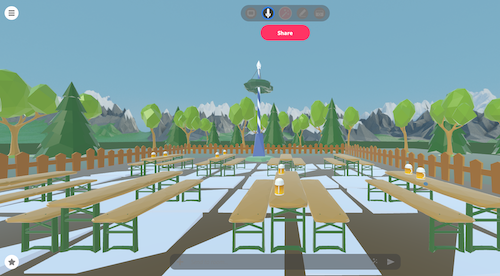
On the Internet, the foyer of the Leibniz Supercomputing Center (LRZ) is shaped like a hexagon. A counter with green plants lays at the heart of it, all around are posters that inform about the data center in Garching, corridors lead to computer and exhibition rooms: Welcome to the Mozilla Hubs. The specialists at the Center for Virtual Reality and Visualization (V2C) at the LRZ have gradually set up seven three-dimensional rooms on the open social platform during the pandemic Year - in addition to a museum, an experimental lab and a mini-biosphere, a computer room, a beer garden and a Christmas market with booth magic can be seen: "Virtual rooms are great for presentations during digital trade fairs and conferences," reports Sabrina Schulte, head of the LRZ PR-team. "They also provide an initial overview of the LRZ and even space for networking and it's also great fun."
Present and inform in an innovate way
Whether the Münchner Medientage, the SC20 supercomputing fair or the Bavarian digital summit – “FutureTech4Climate” the LRZ opened virtual exhibitions for each. A click on a link is all it takes for interested visitors to be right in the middle of things, navigating through labs or museums via smartphone, tablet, notebook or - even better – equipped with virtual reality headsets. Visitors can look inside, surf links to further information and even talk to each other. Other people present are represented as avatars and can be addressed. The closer the avatars are together the better the sound and discussions in the vicinity are louder. In the beer garden, it seems as if the speakers are sitting at the next table - an almost familiar background noise arises. In contrast to trade shows and conferences, virtual rooms can be revisited at any time and immediately reopened. This makes them attractive as innovative way of presenting information for research and educational institutes - even beyond the pandemic. It's no wonder, then, that the LRZ, as a digitization partner for science, is intensively involved with this and now also stages research projects as virtual exhibitions.
Mozilla built the Hubs in 2018. Start-ups, companies or game producers such as Linden Lab, Facebook, VR Chat, Open Simulator or Vircadia developed comparable VR worlds. "We were looking for a platform that represented virtual spaces and for which we didn't need additional software or hardware to create ourselves," explains Elisabeth Mayer, Virtual Reality (VR) specialist at the V2C. Mozilla Hubs is free and data-friendly, accessible without an account, for the architects of virtuality and their guests alike. With Spoke, Mozilla also provides an open-source program for designing and setting up rooms. "Mozilla Hubs has a variety of pre-designed rooms," says Mayer, citing another reason for the choice. "We made all the LRZ rooms ourselves."
Between rich detail and data reduction
In addition to Mayer, specialists Maya Czupor and Kristian Weinand are responsible for the lovingly detailed exhibition rooms: guests can examine the flow of blood in the Circle of Willis there, admire the intricate carvings of book covers as well as historical globes, visit a bog and observe birds there, or discover the LRZ's SuperMUC-NG high-performance computer on a tour. " The procedure of making a room doesn’t only include creation, but also data processing and conversion, as well as many internal tests," Mayer says, describing the process. Each room is different, its appearance shaped by the projects and information presented in it. For this purpose, complex, data-intensive simulations, for example with projects such as Virtual Human, or 3D models of art objects are reduced and prepared so that they are also accessible via the browser and with less powerful, mobile devices: "Most of the models and textures in our visualizations are far too complex for Mozilla Hubs. Therefore, we have to significantly reduce the polygon and pixel density without losing too much information," explains V2C employee Kristian Weinand.
It takes the team about two weeks to build and set up a room. Development work that pays off: the LRZ can show researchers new presentation options and advise them on how to set them up. "Mozilla Hubs is a browser-based program, so we are consequently bound by browser constraints such as computing power and performance," says Mayer, explaining technical limits that have to be observed. "Less is more - in this case, that's to be taken literally. The less you have in the room, the better it runs in the browser." Consequently, the art in virtual worlds is the balance of reduction and richness of detail.
Not all the rooms are opened whole the time, informations about the Virtual World of LRZ, you are able to enter, you will find on LRZ-Website
Tour through the virtual LRZ
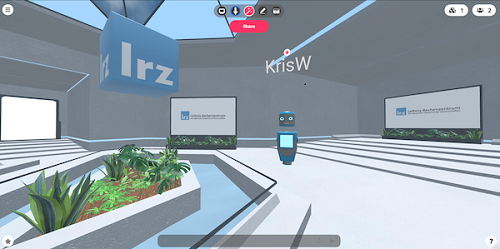
From the lobby you reach the art room with objects of the Bavarian digitization project for museums and art treasures called Bavarikon.
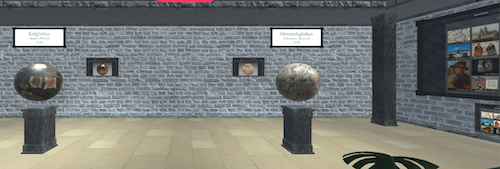
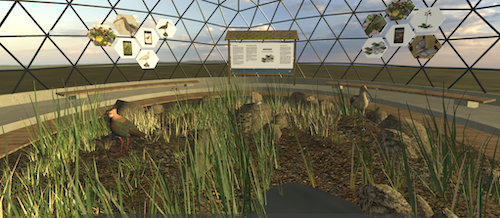
Next door you will find the biosphere of MOOSAIK, where the fauna and flora of a moor can be discovered.
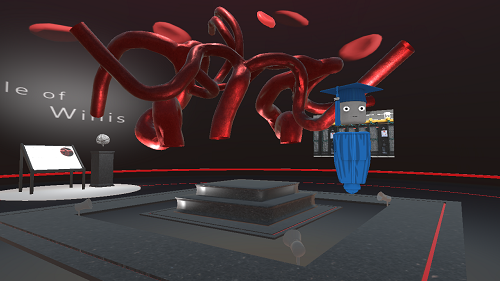
Continue on to the Virtual Human laboratory, where the technical programs for virtualizing biological processes and the basis for the digital twin of humans are being developed.

In between, take a break in the beer garden and arrange to meet friends here. All it takes is a link.
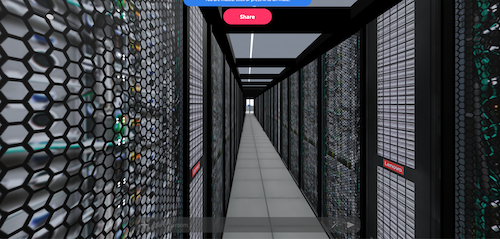
Continue on to the SuperMUC-NG. Walk through the aisles, discover cables and racks of the LRZ supercomputer.
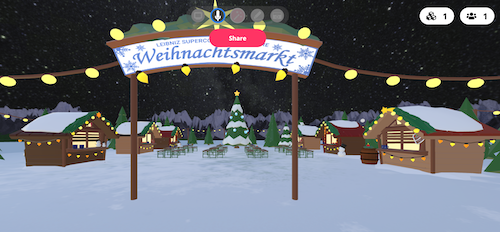
Still in the mood for Christmas? Then take a look at the virtual Christmas-market decorated with LRZ Christmas tree.
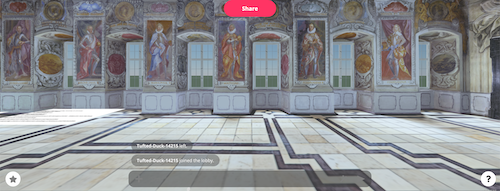
The Corpus der barocken Deckenmalerei in Deutschland (CbDD) conducts research on the interior decoration of walls and ceilings created between 1550 and 1800 within Germany also have two rooms in Mozilla Hubs. The Emperial Hall in Bamberg and the Lusthaus
